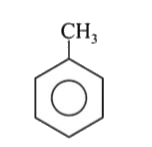In the following sequence of reactions the maximum number of atoms present in molecule ‘C’ in one plane is________.
(A is a lowest molecular weight alkyne).
To solve the problem, we need to analyze the sequence of reactions step by step and determine the maximum number of atoms present in molecule 'C' that are in one plane.
1. Identify the Starting Material (A):
- The problem states that 'A' is the lowest molecular weight alkyne. The lowest molecular weight alkyne is ethyne (C2H2).
2. Reaction in Red Hot Copper Tube:
- When ethyne is subjected to high temperatures in a red hot copper tube, it undergoes polymerization to form benzene (C6H6).
- The polymerization process involves the formation of a cyclic structure where the carbon atoms are connected through pi bonds.
3. Formation of Benzene:
- Benzene consists of 6 carbon atoms arranged in a planar hexagonal structure. Each carbon atom in benzene is sp² hybridized, which means all the carbon atoms and their attached hydrogen atoms lie in the same plane.
4. Addition of CH3Cl in Presence of Anhydrous AlCl3:
- The next step involves the Friedel-Crafts alkylation reaction where methyl chloride (CH3Cl) is added to benzene in the presence of anhydrous AlCl3.
- In this reaction, the methyl group (CH3) will be added to the benzene ring, resulting in a methyl-substituted benzene (toluene).
5. Counting Atoms in Molecule C:
- After the Friedel-Crafts alkylation, we have:
- 6 carbon atoms from benzene.
- 1 carbon atom from the methyl group.
- This gives a total of 7 carbon atoms.
- Each carbon in the benzene ring is bonded to one hydrogen atom, and the methyl group is bonded to three hydrogen atoms.
- Therefore, we have:
- 6 hydrogen atoms from benzene.
- 3 hydrogen atoms from the methyl group.
- This results in a total of 9 hydrogen atoms.
6. Total Atoms in Plane:
- All the carbon atoms (7) and hydrogen atoms (9) are in the same plane due to the sp² hybridization of the benzene ring and the sp³ hybridization of the methyl group.
- Thus, the total number of atoms in molecule 'C' that are in one plane is:
- 7 (carbons) + 9 (hydrogens) = 16 atoms.
Final Answer:
The maximum number of atoms present in molecule 'C' in one plane is 16.
- The problem states that 'A' is the lowest molecular weight alkyne. The lowest molecular weight alkyne is ethyne (C2H2).
- When ethyne is subjected to high temperatures in a red hot copper tube, it undergoes polymerization to form benzene (C6H6).
- The polymerization process involves the formation of a cyclic structure where the carbon atoms are connected through pi bonds.
- Benzene consists of 6 carbon atoms arranged in a planar hexagonal structure. Each carbon atom in benzene is sp² hybridized, which means all the carbon atoms and their attached hydrogen atoms lie in the same plane.
- The next step involves the Friedel-Crafts alkylation reaction where methyl chloride (CH3Cl) is added to benzene in the presence of anhydrous AlCl3.
- In this reaction, the methyl group (CH3) will be added to the benzene ring, resulting in a methyl-substituted benzene (toluene).
- After the Friedel-Crafts alkylation, we have:
- 6 carbon atoms from benzene.
- 1 carbon atom from the methyl group.
- This gives a total of 7 carbon atoms.
- Each carbon in the benzene ring is bonded to one hydrogen atom, and the methyl group is bonded to three hydrogen atoms.
- Therefore, we have:
- 6 hydrogen atoms from benzene.
- 3 hydrogen atoms from the methyl group.
- This results in a total of 9 hydrogen atoms.
- All the carbon atoms (7) and hydrogen atoms (9) are in the same plane due to the sp² hybridization of the benzene ring and the sp³ hybridization of the methyl group.
- Thus, the total number of atoms in molecule 'C' that are in one plane is:
- 7 (carbons) + 9 (hydrogens) = 16 atoms.
The maximum number of atoms present in molecule 'C' in one plane is 16.
Similar Questions
In the following sequence of reactions the maximum number of atoms present in molecule ‘C’ in one plane is________.
Red hot−−−−→Cu tubeCH3Cl(leq.)−−−−−−−−−→AnhydrousAlCl3 (A is a lowest molecular weight alkyne).
View SolutionCH≡CH(Cu-tubes)−−−−−−→Heat[A]CH3Cl−−−−−−→Anhy.AlCl3[B]Cl2−−→Boil[C]
View Solution
Knowledge Check
3CH3=C≡ChRed hot−−−−−−→Cu tube?
A B
B C
C D
D
What is Z in the following sequence of reactions?
PhenolZn−−→dustXCH3Cl−−−−−−−→Alhyd. AlCl3YAlkaline−−−−→KMnO4Z PheAbenzaldehydeBbenzoic acidCbenzeneDtolueneWhat is Z in the following sequence of reactions ?
Phenol Zn dust−−−→XCH3Cl−−−−−−→anhyd.AlCl3ZATolueneBBenzeneCBenzoic acidDBenzaldehyde
In the following reaction, the product 'R' is:
CaC2H2O−−→Phot iron−−−−→tubeQCH3Cl−−−→AlCl3R
View SolutionWhat is Z in the following sequence of reactions?
PhenolZn−−→dustXCH3Cl−−−−−−−→Alhyd. AlCl3YAlkaline−−−−→KMnO4Z Phe
View SolutionCaC2H2O−−→ARed tube hot−−−−−−−→BAlCl3−−−→CH3ClC
In this sequece B and C are.
View SolutionConsider the following reaction :s
Phenol −−−→ZndustXCh3Cl−−−−−−−−−→AnhydrousAlCl3YAlkaline KMnO4−−−−−−−−−−→Z.
The product Z is
View SolutionThe product (C) in the following reaction is
Phenol
underset(Delta)overset(Zn)(to)(A)underset("Anhydrous" AlCl_(3))overset(CH(3)Cl)(t)(B)underset(Delta)overset(KMnO_(4)//OH^(ϴ))(to)(C)
View Solution
